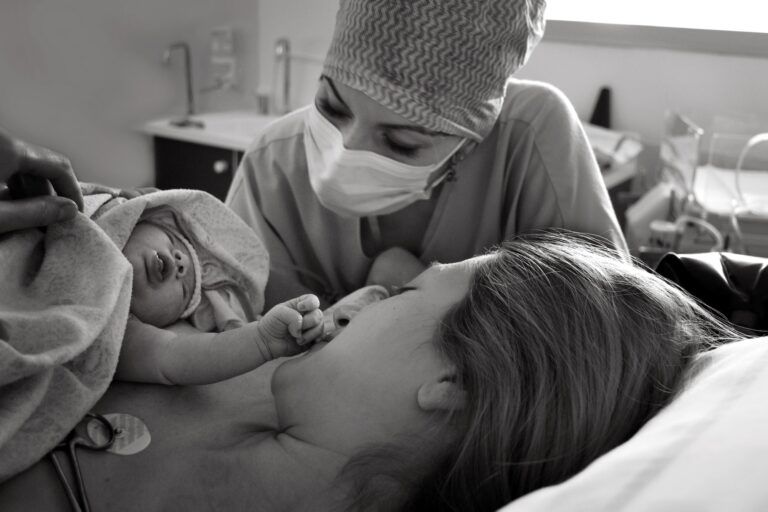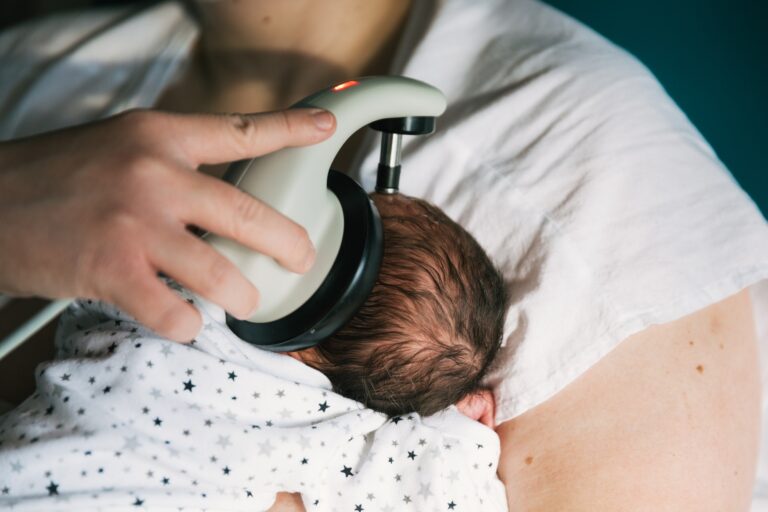
Understanding Patent Ductus Arteriosus: Causes, Symptoms, and Treatment Options
In the intricate realm of cardiovascular health, certain conditions demand our attention, and Patent Ductus Arteriosus (PDA) stands

Women may experience a range of postpartum mood disorders after giving birth, from mild “baby blues” to severe and lasting postpartum depression (PPD). Understanding these conditions is crucial, given their potential impact on new mothers and their families.
Postpartum depression and baby blues have similar causes: profound hormonal changes, physical recovery from childbirth, and the adjustment to caring for a new infant. However, the baby blues is usually a short period of emotional ups and downs that typically gets better within two weeks after giving birth. It may involve feelings of sadness, anxiety, or mood swings.
Postpartum depression, conversely, presents a more severe and persistent experience. Symptoms include intense feelings of sadness, hopelessness, difficulty bonding with the baby, and even thoughts of harming oneself or the baby. If left untreated, PPD can persist for months, often affecting a mother’s ability to care for her newborn and carry out other daily activities.
You cannot overstate the importance of identifying and seeking support for both baby blues and postpartum depression. Although the baby blues is usually transitory, it can escalate to postpartum depression in some women. Timely recognition and response to these conditions, involving professional mental health support, can be instrumental in alleviating symptoms and preventing further complications. Raising awareness and understanding about postpartum mood disorders creates a supportive environment for new mothers, encouraging open conversations and timely support.

“Baby Blues” is a common condition that occurs after childbirth, where a person may experience temporary feelings of sadness, mood swings, and anxiety. It usually starts a few days after giving birth and can last up to two weeks. Women may also experience irritability, restlessness, and crying spells, which can feel overwhelming in the midst of adjusting to a new baby.
After childbirth, women experience significant hormonal shifts, coupled with physical exhaustion from the birthing process and the demands of caring for a newborn. It is during this time that the phenomenon known as baby blues occurs. Baby blues typically emerges within the first few days after giving birth and can persist for up to two weeks. During this period, mothers may experience fluctuating emotions, including mood swings, heightened sensitivity, anxiety, and occasional bouts of sadness.
These temporary feelings are considered a normal response to the intense physical and emotional changes that accompany childbirth and the early stages of motherhood. It’s important to note that with proper support, reassurance, and self-care, the symptoms of baby blues generally subside, allowing new mothers to adjust to their new role and bond with their baby.
Despite its challenges, it’s important to understand that experiencing baby blues is perfectly normal and affects up to 80% of new mothers. The transitional period after childbirth can be highly stressful, and it’s completely natural for your mood to fluctuate during this time.
To cope with baby blues, self-care and support are key. Regular rest, balanced nutrition, and light physical activity can help to manage mood fluctuations. Additionally, sharing feelings with a supportive network, such as a partner, family, friends, or other new mothers, can provide much-needed emotional relief. It may be indicative of postpartum depression if the feelings of sadness persist for more than two weeks or become more intense. In this case, mothers should seek professional medical assistance.

Postpartum Depression (PPD) is a significant mental health condition that can affect women after giving birth. It usually starts within the first few weeks to months after delivery. The symptoms of PPD are more severe and persistent than those of baby blues. These symptoms include intense sadness, feelings of hopelessness, extreme fatigue, and difficulties bonding with the baby.
Several factors can increase a woman’s likelihood of experiencing PPD. Certain factors can heighten the likelihood of experiencing postpartum depression (PPD). These factors include a history of depression or anxiety, challenging childbirth, limited social support, and stressful events during pregnancy or after giving birth.
The fundamental differences between baby blues and postpartum depression lie in the duration and severity of symptoms. PPD is much longer-lasting and tends to persist for months, affecting a woman’s well-being and ability to function profoundly. Baby blues last for up to two weeks with milder symptoms.
You cannot emphasize enough the importance of seeking professional help if you suspect PPD. PPD is a serious condition that can affect not just the mother’s health but also the baby’s development and the overall family dynamic. Fortunately, effective treatments are available, including therapy, medication, and support groups. Early intervention is key, and no woman should suffer in silence or feel alone in this struggle. Recognizing postpartum depression and reaching out for help is an essential step towards recovery.

Recognizing the key differences between baby blues and postpartum depression (PPD) is crucial for timely and appropriate interventions. Postpartum depression is a more severe and persistent condition compared to baby blues. People with postpartum depression often feel very sad and hopeless and lose interest or enjoyment in activities. They may also have trouble forming a bond with the baby. In contrast, baby blues symptoms are milder, involving temporary mood swings, feelings of sadness, and anxiety that usually appear a few days after childbirth.
A primary distinguishing factor is the duration of these conditions. Baby blues typically lasts only a few days to a week or two post-delivery, while PPD can persist for months or even longer. Moreover, if left untreated, PPD symptoms can progressively worsen over time, leading to more severe complications.
One alarming symptom exclusive to PPD is the emergence of suicidal thoughts or thoughts of harming the baby. Such severe psychological distress warrants immediate professional attention.
PPD can also severely impact a woman’s ability to care for herself and her baby. This disorder can disrupt daily functions, making it difficult for the mother to perform routine tasks or meet her baby’s needs. Such implications are typically absent in baby blues, further underlining the importance of distinguishing between these two postpartum mood disorders. Awareness and understanding of these differences can guide effective response and support for the mental health of new mothers.
In conclusion, differentiating between baby blues and postpartum depression is crucial due to their significant impact on a new mother and her family. Do not overlook these postpartum mood disorders, which may vary in intensity and duration. Seek professional support when any symptoms become apparent. If you or a loved one are experiencing symptoms of baby blues or postpartum depression, don’t hesitate to seek help. Your feelings are valid and deserve open discussion. A wide range of effective treatments and supportive resources exist to assist during this challenging time.
For those struggling with postpartum mood disorders, know that you are not alone, and recovery is not just a possibility but a probability. With the right help and support, you can navigate this challenging phase and move towards a brighter, healthier future for you and your family.
1. What are the differences between baby blues and postpartum depression?
Baby blues usually occurs shortly after childbirth and lasts for up to two weeks, with mild symptoms like mood swings, anxiety, and sadness. Untreated postpartum depression, on the other hand, presents more severe symptoms, such as intense sadness, hopelessness, and difficulty bonding with the baby.
2. What are the symptoms of baby blues?
The symptoms of baby blues can include mood swings, anxiety, sadness, irritability, and feeling overwhelmed. These symptoms typically begin a few days after childbirth and resolve within two weeks.
3. What are the symptoms of postpartum depression? Symptoms of postpartum depression can include intense sadness, feelings of hopelessness or worthlessness, difficulty bonding with the baby, excessive crying, and loss of appetite. In severe cases, thoughts of suicide or harm to the baby may also be present.
4. How long does baby blues last?
Baby blues typically lasts only a few days to a week or two after childbirth. However, if symptoms persist beyond two weeks, it could be a sign of postpartum depression.
5. How long can postpartum depression last? Postpartum depression can last for months or even longer if left untreated. Early identification and treatment are crucial to managing this condition effectively.
6. Is baby blues normal after giving birth? Yes, experiencing baby blues is normal and affects up to 80% of new mothers. However, if symptoms persist or become more severe, it’s important to seek professional help as it could be a sign of postpartum depression.
7. What are the risk factors for developing postpartum depression instead of baby blues? Postpartum depression risk factors include history of depression or anxiety, limited social support, stressful life events, and hormonal changes during and after pregnancy. These factors increase the likelihood of developing postpartum depression instead of experiencing baby blues.
8. Can baby blues develop into postpartum depression?
While baby blues are a common experience after childbirth, they usually resolve on their own. If symptoms worsen or persist beyond two weeks, seeking professional help is important, as it could indicate postpartum depression.

In the intricate realm of cardiovascular health, certain conditions demand our attention, and Patent Ductus Arteriosus (PDA) stands

Guidance for Healthy Baby’s Growth Charting a birth plan is like GPS for natural childbirth—a guide for a
Pregnancy, often considered a period of joy and anticipation, can sometimes be fraught with complications. One such condition

Each parent envisions a healthy future for their child, including auditory well-being. Early identification of hearing impairments through